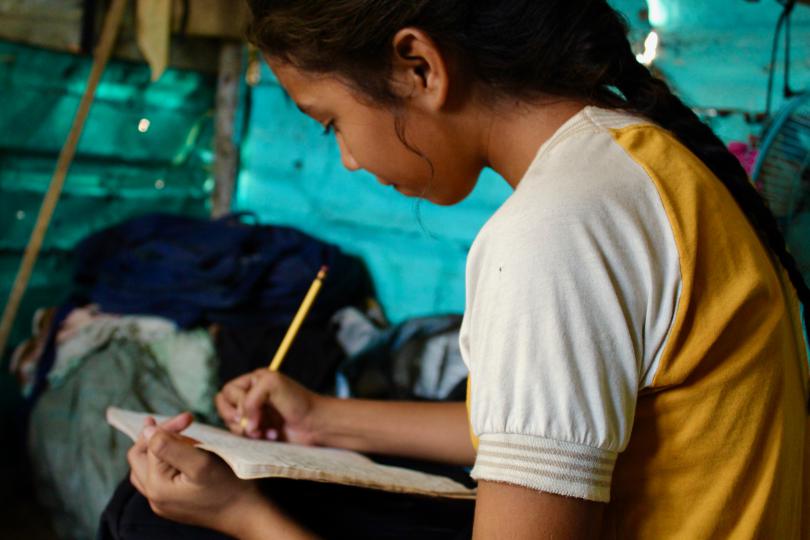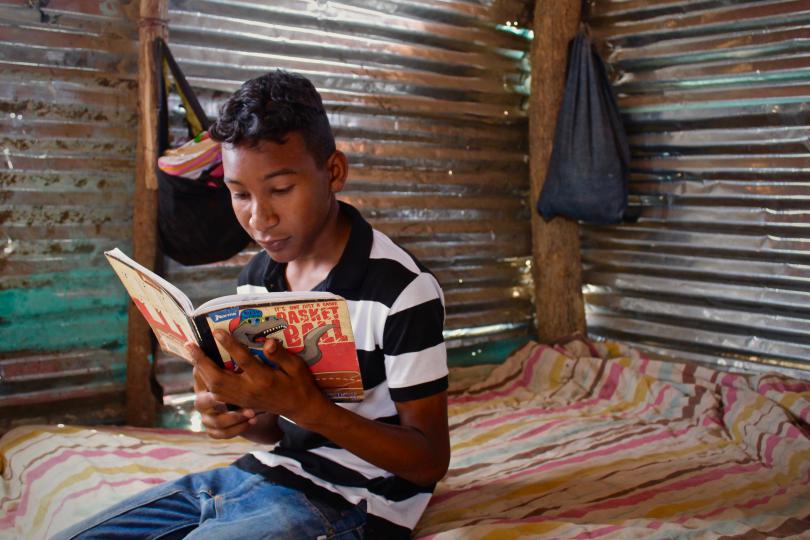Time for a safe back to school in Latin America and the Caribbean

By Maria Gabriela Alvarado, Regional Media Coordinator, LAC Regional Office
The COVID-19 pandemic has put the dreams of more than 159 million children and adolescents in Latin America and the Caribbean[1] on a long pause, all of whom have been affected by excessive periods without classes.In this region an average of 168 school days have been lost without face-to-face interaction since schools closed in March 2020 until early February 2022[2].
Latest reports on the state of education in Latin America during the COVID-19 pandemic says that 9 countries have fully reopened their schools, 14 are partially closed and 7 are fully closed. In addition, 7 countries and territories are currently on academic recess[3].
Three teenagers, Paula from Colombia, Ana from Peru, and Nicole from Guatemala have tried to continue their studies and stay motivated despite restrictions, fear of catching COVID-19 and grief in their environments. They live in different countries, but with very similar realities in this pandemic context. We sat down with them, and they told us about how COVID-19 and other crises and conflicts have changed education in their countries. They also told us about their lived experiences, perceptions, and recommendations for the future.
"COVID-19 put all areas of life in limbo, and education was a fundamental point because it is failing for many children in my country and the world,"Nicole highlights.
"There are many children who don't have access to remote education and there are others who do, but even they struggle to learn. All of our classmates have dreams and want to enter university, but it is very difficult because those who study online are privileged. This means that it’s even more difficult for some children to get to university while everything is virtual - if you have no food, no work, no money and no connection to the Internet, everything becomes much more complicated”, says Paula.

Despite the efforts made by governments to provide formal learning alternatives permanently or partially through distance, face-to-face or blended learning, it has not been enough to mitigate the effects of the pandemic on mental health and ensure quality learning for all girls and boys, especially the most vulnerable. The pandemic has gravely affected the day-to-day lives of hundreds of thousands of children and adolescents and put their futures at risk.
Paula and Ana agree that:"Distance learning has been quite chaotic. We can't say it's the teachers' fault that we don't learn as we have to put ourselves in their shoes. If we get frustrated, so do they: being in front of a screen with nobody responding to you. Before the pandemic they didn't even have Internet. Now they have to pay for it out of their own pockets. Many teachers do not know how to handle the platforms, and for the students it is much more difficult to understand virtual lessons than face-to-face ones”.
As a result, many of my classmates are demotivated to study –Ana says:“they have a more negative view of things and no longer see the point in studying. Many are even saying "I can work". Many have lost motivation and have decided to drop out of school and not continue their studies because they can see that their goals will not be met”.
The reality of children and adolescents in Latin America and the Caribbean is that they have not gone back to school for a multitude of reasons: because their school has not reopened, or they have lost their caregivers, or they have to work to support their household. In the case of adolescents, they have become prematurely pregnant or have been recruited by criminal organizations who have taken advantage of their vulnerability, amongst other terrible circumstances in which none of them should be.
Victoria Ward, Save the Children's Regional Director for Latin America and the Caribbean, highlights that the most vulnerable children and adolescents are the most affected by the COVID-19 pandemic and the impact on their education has been devastating. “Although the process of reopening schools continues to advance in the Latin American and Caribbean region, more than 60 million children and adolescents are still affected by total and partial school closures. We can’t leave these children behind. Schools need to reopen safely and put in place plans to mitigate the effects of prolonged closures.”

Access to technology and efficiently managing technological tools has been challenging for thousands of students and educators. "Many children and adolescents do not have connectivity. Rural areas were the most affected. There were some initiatives where the government lent SIM cards, but they can only be used in very open areas. They want to solve the problem, but it doesn't work very well. Many children were left without education because the government did nothing to support them," says Paula.
The educational reality of the region during the pandemic crisis highlighted the great challenges each country faces in providing access to education in times of crisis. February 2022 reports state that 21 countries and territories continue school lessons through remote learning via online or television, radio, WhatsApp, printed materials and/or hybrid models.
Prioritizing vaccinations for students and educators have also taken a lot of time. Now 21 countries and territories of the region have prioritized teachers and 23 have prioritized students in the COVID-19 vaccination process [4].
"Getting the vaccine would be the safest thing to do to be able to return to school. The government would have to seek an agreement with parents to be able to do this. I don't know exactly what solution can be given - if I thought of it, I would have thought of it for the authorities too," says Ana.
Paula (16), Ana (17) and Nicole (17) are young leaders in their communities and have a lot to say about what they experienced in the last two years. They belong to the GANNAR group, a group of children and adolescents who advise and participate in Save the Children's programs and projects in Latin America.
"In GANNAR we are a group of girls, boys and adolescents who have the common goal of promoting and defending our rights, to be the voices that generate proposals and influence lasting changes for our development and that of our communities," says Nicole.
Paula says, "Through GANNAR we promote change in Latin America and the Caribbean by raising our voices and sharing our opinions, ideas and feelings."
"We also promote, disseminate and defend our rights for the development and wellbeing of children in the communities and countries of the region," says Ana.
Paula, Ana and Nicole have put forward some recommendations they would give to the authorities.
For Paula, going back to school would solve many of the pains they have suffered in recent years due to school virtuality. "The solution would be to go back to face-to-face classes, many things would be solved. Schools are safe environments. If there is violence at home, you feel safer at school. Also, your school is a protective environment where you can develop well, you have food and teachers. It is very important to go back to schools in a safe way".
Ana says: "In my district, there are areas that are poorer than others and there should be a proper study of the real situations we are going through. The government should take a more in-depth approach with the Ministry of Education. In my school, we still do not have teachers or teachers who are doing the work of other teachers. It would be good to make a work plan or a study of the students in the schools because there are many children who do not have the privilege of studying and we have to help them."
Regarding the mental health of the students, Nicole says: "The solution is that there should be a return to classes and psychological counseling in the schools. In my school, there have been some workshops. But it is not the same thing as having individualized counseling to make it more personalized so that we can go deeper and try to motivate students to continue with their studies".
The three adolescent community leaders reinforce the message of the need to return to school in person. The children and adolescents of Latin America and the Caribbean have the right to be educated. It is time to go back to school.
____________________________________________________
[1] Datos obtenidos de la Organización de las Naciones Unidas para la Educación, la Ciencia y la Cultura, Instituto de Estadística (Welcome to UIS.Stat).
[2] DATE 32 ESTADO DE REAPERTURA DE LAS ESCUELAS [Publicado el 15 de febrero de 2022] Informes sobre la situación de la educación durante COVID-19 UNICEF LACRO
[3] DATE 32 ESTADO DE REAPERTURA DE LAS ESCUELAS [Publicado el 15 de febrero de 2022] Informes sobre la situación de la educación durante COVID-19 UNICEF LACRO
[4] DATE 32 ESTADO DE REAPERTURA DE LAS ESCUELAS [Publicado el 15 de febrero de 2022] Informes sobre la situación de la educación durante COVID-19 UNICEF LACRO

